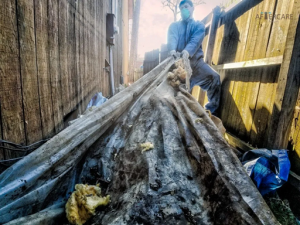The crawl space beneath your home is an area that is often overlooked, but its maintenance is crucial to the overall health of your home. One aspect of this is preventing animal infestation, which, if left unchecked, can lead to a host of problems, including structural damage and health issues due to animal waste and parasites. This guide will provide insights into effectively preventing animal infestation in your crawl spaces, explored from different angles to ensure a comprehensive understanding of the matter.
Understanding your Crawl Space
Primarily, a clear understanding of your crawl space is essential. Typically, a crawl space is an area beneath your house, about one to three feet in height, providing access to your home’s pipework and electrical wiring. Its purpose extends beyond this, also including foundational support and prevention of the ground’s dampness from affecting the home. Properly maintained, it plays a crucial role in the overall health and stability of your house by managing moisture and allowing for necessary repairs. However, with its dark, secluded nature, it poses as an ideal breeding ground for rodents and pests if not properly managed. This makes regular inspection and upkeep critical to prevent infestations and structural issues.
Recognising the Threats
Various animals find the crawl space an attractive haven due to its shelter and accessibility. Common inhabitants include rats, mice, raccoons, skunks, and even stray cats, which can easily enter and make themselves at home. Insects such as termites, ants, and cockroaches are also frequent intruders, drawn by the damp and secluded environment. The consequences of these uninvited guests range from damaging your home’s structural integrity through gnawing or burrowing to compromising insulation and wiring. Additionally, they can pose health risks by transmitting diseases via droppings and fleas, which can affect both humans and pets. The presence of these pests highlights the importance of maintaining a clean and well-protected crawl space to safeguard your home and health.
Preventive Measures
When pondering over a guide on preventing crawl space infestation, it is important to take a diverse approach. The first step is to make it less inviting to animals. This could involve ensuring the crawl space is adequately sealed to prevent entry. Regular maintenance and checks are also vital. This would help spot any small openings that animals might use as access points, which can then be effectively blocked.
Natural repellents can also be utilized to keep pests at bay. Certain plants, such as mint and citrus, are known to repel rodents due to their strong scents that are unpleasant to these animals. Additionally, sprinkling crushed red pepper flakes can deter raccoons, as the spiciness irritates their sensitive noses and discourages them from entering the area. These natural methods provide a non-toxic, environmentally friendly way to help prevent infestations in your crawl space.
A Clean, Dry and Well-lit Crawl Space
Maintaining a clean, dry, and well-lit crawl space can effectively discourage animal infestation. Animals are attracted to clutter as it provides hiding spots, so enforce a strict ‘no clutter’ policy for your crawl space to eliminate potential nesting areas. Additionally, remove any standing water or fix leaks promptly, as these can serve as water sources that attract pests.
Consider investing in crawl space encapsulation, which involves lining the floors and walls with a high-performance waterproof material. This not only creates a barrier between the home and the earth, keeping the space dry, but also improves energy efficiency by preventing moisture-related issues.
The use of lighting is also an effective deterrent. Animals typically prefer low-lit areas, so keeping your crawl space brightly lit will make it less appealing to them and help prevent intrusions.
Engaging Professional Help

It is advised to use expert pest control services for large infestations. They possess tools, techniques, and experience much needed in dealing with and preventing repeated intrusion. Using a professional service also eliminates the risk of close encounters with potentially dangerous or infected animals.
Maintaining vigilance
After implementing preventive measures, maintaining continuous vigilance is critical. Regular checks can help detect signs of infestation early, allowing for prompt action before the problem escalates. These inspections ensure that your implemented barriers, such as encapsulation or natural repellents, remain intact and effective. Consistent monitoring also helps identify any new vulnerabilities in your crawl space, enabling you to address them swiftly and maintain a pest-free environment.
Dealing with Animal Contamination in your Crawl Space
Despite your best efforts, if animals do infiltrate your crawl space, it is crucial to clean it thoroughly. You can follow this comprehensive guide on preventing crawl space infestation to ensure complete and effective clean-up.
In conclusion, prevention is always better than cure when dealing with animal infestation in your crawl space. It is far more cost-effective and less stressful to take the steps outlined in this guide to prevent animals from infiltrating your crawl space than it is to deal with the aftermath of an infestation. Regular inspections, cleaning, the use of natural deterrents, professional help when needed, encapsulation, and good lighting are all effective strategies you can employ to protect your house from unwanted animal visitors.
Feature Image credit

